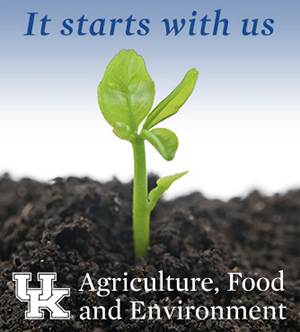By Katie Pratt
University of Kentucky
As the COVID-19 pandemic continued to alter Americans’ everyday lives, an office of the University of Kentucky Cooperative Extension Service used the pandemic as an opportunity to foster community pride and promote its town’s local economy and history.
Samantha Saunders, Robertson County extension agent, worked with community partners to design a scavenger hunt through the county showcasing its history.
“I wanted to get the community involved in a fun activity they could do together as a family while social distancing,” said Saunders, who is the county’s agriculture and natural resources and 4-H youth development agent. “Our county has so much history that so few people know about. The scavenger hunt was a way to increase awareness of the historical people, places and events that occurred in the county.”

Andrew (left) and Nate Gray stand in front of the historic Louisiana Hotel in Robertson County. They found the hotel with their parents as part of the Robertson County scavenger hunt.
Saunders and Kristy Allison, a high school teacher and local business owner, had the idea for the community-wide scavenger hunt prior to the pandemic. When the pandemic began, they saw it as a good opportunity to move the project forward, because people were looking for things to do outside of their homes.
Located in the northeast corner of the state, Robertson County is the smallest county in Kentucky by total area and population, and it has a rich history. It is the location of Blue Licks Battlefield State Resort Park, which is the site of one of the last battles of the Revolutionary War. It is also home to one of the last covered bridges in the state.
“I wanted people to learn about the history of our county, because people develop more pride when they learn about a place,” Allison said. “It was also a fun family activity that got people outside.”
Robertson County families participated by going to the county extension’s Facebook page and extension office for clues written by Allison about local historical attractions each Monday for a month during the summer. They would have a week to email Saunders the answers to the scavenger hunt along with a picture of them at the location.
Saunders said many people returned each week to participate, including resident Amanda Gray.
“My husband, two sons and I participated in the hunt,” Gray said. “We used the clues to find answers to questions about historical landmarks in Robertson County, and then we traveled to those sites.”
Individuals that correctly found the answers to the weekly hunt were put into a Facebook Live drawing for prizes donated by local businesses.
“We had 23 businesses that donated, and about half of those we didn’t know existed prior to this event,” Allison said. “The project was a good way for us to market local businesses to our residents and stress the importance of shopping local.”
Due to the program’s success, Saunders plans to host the program again next year.
Katie Pratt writes for the UK College of Agriculture, Food and Environment.



















